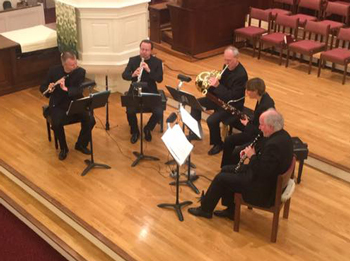by Mike Telin

From the first note to last, the Berliners — Michael Hasel, flute, Andreas Wittmann, oboe, Walter Seyfarth, clarinet, Fergus McWilliam, horn, and Marion Reinhard, bassoon — filled Plymouth Church with a rich, full-bodied sound during their far-reaching program.
Just as Haydn was the father of the string quartet, Anton Reicha is credited as being the first major composer to write for the wind quintet. The Berliners paid tribute to Reicha’s contributions to the wind music canon with a charming performance of his Andante arioso for English Horn and Woodwind Quartet, which opened the program. Although each instrument gets its moment to shine, the eight-minute work is a showcase for the English horn, and Andreas Wittmann sounded wonderful, especially during the cadenza.
Composed for the ensemble in 2014, Finnish composer Kalevi Aho’s Quintet No. 2 is a fascinating four-movement work that explores every hue of the sound palette that wind instruments — including piccolo, alto flute, and English horn — are capable of producing. Symphonic in structure, Aho’s Quintet begins with the fourteen-minute “Ruhig beginnend—Bewegter.” Opening with soft, dark sonorities that gradually build to a fiery climax, the movement sets the tone for the entire piece.
The second movement (“Sehr schnell, wild”) is an untamed march featuring a dazzling piccolo solo. A pensive bassoon solo begins the contrasting, slow movement (“Ruhig fließend”), and Aho brings the Quintet to a close with a lighter, yet still energetic finale (“Lebhaft”). Following the opening clarinet solo, the movement becomes ever more frenzied until it collapses, fading into silence with a long-held note from the English horn.
György Ligeti’s Six Bagatelles provided a humorous interlude, spanning a range of emotions and musical gestures. They’re short enough that if you didn’t care for one of the pieces, you had only to wait a minute or two for the next one. The Berliners’ technically superb and musically adroit performance brought out the individual character of each “little nothing,” from the spirited to the elegiac (including an Adagio in memory of Belá Bartók). You could imagine the final Capriccioso as the soundtrack to a Tom and Jerry cartoon.
Carl Nielsen’s Quintet in A, Op. 43 is a standard of the wind quintet literature, and the Berliners brought off a polished, no-fuss performance to end the evening. The attractive variations that form the last movement are little character sketches of members of the Copenhagen Wind Quintet for whom Nielsen wrote the piece. Each of the Berlin players brought their own personal style to the task in a performance that sparkled with color and imagination. The concluding Andante festivo made a grand ending, its final chord resonating boldly in the hall, grounded by bassoonist Marion Reinhard’s low A.
The enthusiastic audience was not going to let the evening end there. The Quintet obliged with a short suite of American folk tunes.
Photo: Colin Roshak.
Published on ClevelandClassical.com February 22, 2017.
Click here for a printable copy of this article



